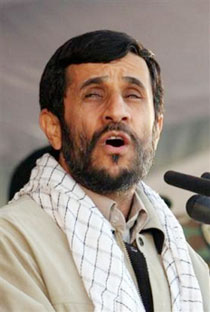TEHRAN, Iran - Iran conducted its second major test of a new missile within
days on Sunday, firing a high-speed torpedo it said no submarine or warship can
escape at a time of increased tensions with the U.S. over its nuclear program.
The tests came during war games that Iran's elite Revolutionary Guards have
been holding in the Persian Gulf and the Arabian Sea since Friday.

Iranian President
Mahmoud Ahmadinejad speaks during a rally of paramilitary forces in
support of the country's nuclear program in Tehran, Iran, Saturday, Nov.
26, 2005. [AP] |
On the maneuvers' first day, Iran
said it successfully tested the Fajr-3 missile, which can avoid radar and hit
several targets simultaneously using multiple warheads.
The new torpedo, called the "Hoot," or "whale," could raise concerns over
Iran's power in the Gulf, a vital corridor for the world's oil supplies and
where the U.S. Navy's 5th Fleet is based. During Iran's war with Iraq in the
1980s, Iranian ships attacked oil tankers in the Gulf, and Iran and the U.S.
military engaged in limited clashes.
Iran's state television stopped its normal programs to break news of the
torpedo test, showing it being launched from a ship into the Gulf waters, then
hitting its target, a derelict ship.
Gen. Ali Fadavi, deputy head of the Revolutionary Guards' navy, said the
ships that fire the Iranian-made Hoot had radar-evading technology and that the
torpedo ¡ª moving at 223 miles per hour ¡ª was too fast to elude.
"It has a very powerful warhead designed to hit big submarines. Even if enemy
warship sensors identify the missile, no warship can escape from this missile
because of its high speed," Fadavi told state television.
The Hoot's speed would make it about three or four times faster than a normal
torpedo and as fast as the world's fastest known underwater missile, the
Russian-made VA-111 Shkval, developed in 1995. It was not immediately known if
the Hoot was based on the Shkval.
The new weapon gives Iran "superiority" against any warship in the region,
Fadavi said, in a veiled reference to U.S. vessels in the Gulf. It was not
immediately clear whether the torpedo can carry a nuclear warhead.
Cmdr. Jeff Breslau, spokesman for the U.S. 5th Fleet based on the tiny Arab
island nation of Bahrain in the Gulf, said no special measures were taken in
reaction to the Iranian war games, even after the latest missile test.
He would not comment on whether the new torpedo represents a threat to
American forces in the region.
"In general terms, no matter where we operate in the world, we're aware of
other capabilities that exist and of other countries that aren't as friendly to
the U.S., and we pay attention to those capabilities," he said.
The U.S. and Iranian navies have had brush-ups during the past ¡ª during the
"Tanker War," when U.S. warships moved into the Gulf to guard oil tankers.
In 1988, the frigate USS Samuel B. Roberts was badly damaged by an Iranian
mine. In response, the U.S. Navy launched its largest engagement of surface
warships since World War II. Two Iranian ships were destroyed, and an American
helicopter was shot down, killing the two pilots.
Iran is now trying to show its strength amid worries of U.S. military action
over its nuclear program, which Washington says aims to produce nuclear weapons.
Iran denies the accusation, saying it intends only to generate electricity.
The U.N. Security Council has demanded Iran give up uranium enrichment, a
crucial part of the nuclear process. Washington is pressing for sanctions if
Tehran continues its refusal to do so, though U.S. officials have not ruled out
military action as an eventual option, insisting they will not allow Iran to
gain a nuclear arsenal.
Iran's president, Mahmoud Ahmadinejad, has warned that the United States will
"suffer" if it takes action against its nuclear program. Some have seen that as
a threat to increase militant action in the region or turn to the oil weapon,
though Iranian oil officials have ruled out any squeeze in supplies.
Iran, which views the United States as an arch foe and is concerned about the
U.S. military presence in neighboring Iraq and Afghanistan, says the maneuvers
aim to develop the Guards' defensive capabilities.
The United States and its Western allies have been watching Iran's progress
in missile capabilities with concern. Iran already possesses the Shahab-3
missile, capable of carrying a nuclear warhead and hitting U.S forces in the
Middle East.
The upgraded version of the ballistic Shahab-3 missile can travel about 1,200
miles, putting Israel within easy range.
Fadavi said Sunday's torpedo test was the outcome of six years of hard work
at the Iranian Aerospace Industries, affiliated with the Defense Ministry.
More than 17,000 Revolutionary Guards forces are taking part in the weeklong
maneuvers in the Gulf.
On Sunday, guards paratroops practiced a drop in an attack on a mock enemy
position, and warships, jet fighters, helicopters and sophisticated electronic
equipment were used in other exercises.
The television report said Sunday's war games included measures to respond to
electronic jams caused by a mock enemy.
Iran has routinely held war games over the past two decades to improve its
combat readiness and test locally made equipment such as missiles, tanks and
armored personnel carriers.
Iran launched an arms development program during its 1980-88 war with Iraq to
compensate for a U.S. weapons embargo. Since 1992, Iran has produced its own
tanks, armored personnel carriers, missiles and a fighter plane.